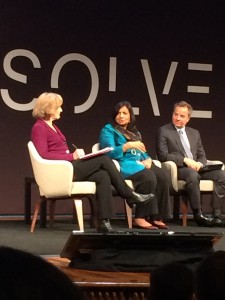Solving Global Problems: Cure, Fuel, Learn, Make
-
-
slice.mit.edu
Filed Under

Recommended
Caption: Earth Institute’s Jeffrey Sachs says Solve’s goals align with the UN’s new sustainability goals.
The average lifespan in the developing world is 57. Worldwide measures are required to hold climate change to a 2-degree rise and even that will spur a new era of destructive storms and agricultural shortages. Those facts underscored the dramatic problems facing today’s decision makers—and the hard truth that solutions are not in place. Solve, MIT’s Oct. 5-8 gathering, drew participants from 30 countries to examine problems and propose solutions to major challenges in health care, energy, the environment, food and water supply, education, civil infrastructure, and the economy.
The good news is that resources, technologies, and innovation can lead to many solutions. A Sprint executive at the opening session, for example, announced that his company plans to spend $100 million to provide free broadband access to teens, so they can take advantage of 21st century opportunities in education and entrepreneurship.
Linking up people and organizations committed to developing solutions—and then acting on them—is one goal of Solve. In his keynote, Jeffrey Sachs, an economist and director of the Earth Institute at Columbia University, detailed how Solve’s agenda overlaps with the 17 new sustainable development goals the United Nations unveiled in September—and he noted that the timing is critical.
“We are within reach on ending extreme poverty in the world and we are also with reach of blowing ourselves up,” says Sachs. “It's a pretty strange world we are living in.”
Solutions include a call for universal Internet access, which is critical for improving education, health care, emergency relief, and alleviating poverty. Nicholas Negroponte ’66, MArch ’66, founder of the MIT Media Lab, predicted that “connectivity will become a human right.” In addition to the Sprint announcement, Yael Maguire SM ’99, PhD ’04, of Facebook described the company’s program to extend Internet access via solar-powered planes and Rich Devault of X Labs, a division of Google’s new umbrella company Alphabet, said his company is aiming for the same goal with balloon technology.

Connectivity via cell phones and social media is already saving lives, says Josette Sheeran, head of the Asia Society. Her career has spanned roles such as managing emergency food aid as the executive director of the United Nations World Food Programme. When she arrived in Haiti shortly after the 2010 earthquake, the only way to find out whether food was actually arriving in remote areas was via Twitter. “The phone is a life-saving device and Twitter, a truth teller and a lifeline for the world,” Sherran says.
Solve is not a one-time event. MIT President L. Rafael Reif told the opening session on Monday that his dream for Solve is to connect the people and organizations who will continue to work for positive change. And, he says, MIT is good at harnessing the energy of diverse groups.
“MIT is a fantastic mosaic, an intermingling of people, ideas, and cultures from every corner of the world and a place where we have been known to have strong points of view.” Reif noted. “And here is the beautiful thing I’ve witnessed over and over. When we get very different people focused on very hard, meaningful problems, whatever differences are at the beginning disappear and people achieve amazing things. That is gratifying for everyone involved.”
Explore Solve’s four themes: Cure, Fuel, Learn, and Make and read MIT News office articles. Find out which MIT alumni spoke at Solve and at HUBweek, a coordinated festival celebrating ideas and innovation hosted by MIT, Harvard University, the Boston Globe, and Mass General Hospital.







